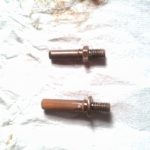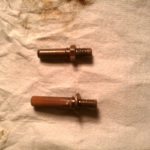Just a heads up. I now have 54K miles on my motorcycle and the Rear Caliper Has locked up on me. Why is this? Sit down and grab a soda, coffee, tea, and I’ll tell you how.
The GS adventure uses what is called a floating caliper design (this is a common design on motorcycles). The caliper is attached to a bracket and that bracket is attached to the rear axle. When the rider hits the brakes only one side of the caliper has pistons which push the pads against the rotor. While this is happening the caliper then slides on the pins so the other side is taunt against the rotor. This push pull action is what allows us to slow down or come to a stop at the light.
So what happens when something goes wrong?
I’m glad you asked. In my case the pins that the rear caliper slides on have become so corroded that the caliper no longer slides. When I hit the brakes the piston pushes against the rotor and the caliper doesn’t slide over for the extra surface area. I have roughly half of the breaking force. This was caused by water (from river crossings) and Road Salt from winter riding making its way onto the pins. The elements were able to attack the pins because apparently I had a Teeny weeny hole in the rubber boot, which didn’t become apparent until I sprayed penetrant in there and noticed it was bubbling out in the middle of the boot.
So what is the fix?
Another good question you have there. Soak the pins with penetrant and hope you can break the caliper from its cell. Then grind off the corrosion and use a good grease. Most people use Bel Rays marine grease (it helps protect against the corrosion caused by salt and water).
What happens if I can’t get the caliper apart?
Well, now you are in the predicament I am in. Soaking the caliper for 3 days in penetrant, which has eaten away the rubber boots. Also using an industrial heat gun to heat up the caliper haven’t resulted in the desired effect of the caliper sliding. I’m left with a few options. I can either drill through the cover of the caliper, hammer the &@^# out of the pin to try to break it free, then weld up the hole I just made. I can order a rebuild kit from BMW or Brembo, cut the pins, drill out the pins, clean and rebuild (This isn’t an option see Note below). Replace the Caliper with either used from Beemer Boneyard, or new from $475 from BMW.
So from here on out every 12K service I am going to remove the calipers, slide out the pins, clean, re-grease. I’m still working on breaking mine apart. Typical BMW owner I am, Cheap.
So what was the see note you were talking about?
Oh yes, I digressed, so I called a few dealerships, the plus side there are part numbers for the rubber boots from BMW. The part number is as follows. 34 21 23 30 312.
There is light at the end of the tunnel to get a rebuild kit?
Not so fast Tonto, BMW doesn’t sell the pins seperate, their claim, You need to buy a whole new caliper even though a sub $10 piece is broke.
Seriously?
Yes.
Ok, So my brakes are made by Brembo, I’ll call them surely they make a rebuild kit for their own brake kits right?
Good Idea, I’ve already done the leg work and guess what. They have an agreement and do not make rebuild kits for the BMW calipers. If you want a rebuild kit you have to get them through the manufacturer.
I don’t get it, Why are the pins removable if I can’t remove the pins and replace them if they get corroded?
That is the million dollar question sir. Thanks for playing.
But Nate, Why are you typing this up for the whole club to read?
Your level of observation astounds even me, I only wish I could have had the foresight to know that the pins are susceptible to corrosion. Why they don’t use stainless steel for the sliding pins should be another question that I wish I could ask the engineers at BMW. But I wrote this up under the maintenance post so that you are aware of the problem.
After talking to Gateway BMW in St Louis, I have found out this is actually quite a common problem that they have seen. In fact I got the rubber boot part numbers from them (Shannon in service had them memorized).
So learn the lesson from me and my dealings with my bike. If you have a floating caliper design, don’t negate them from your maintenance. It’ll take 5 to 10 min. per caliper to check the pins, inspect the boots, clean, and regrease. That 5 to 10 min. will save you a lot of heartache, Downtime on the bike while hunting parts, and easier on the wallet at over $400 bucks a pop for calipers.
Please post your experience or ideas below in the comments.
Nate
EDIT-I GOT THE BASTARD! You can see why it took 4 days of penetrant and a BFH!
UPDATE- Jul 11, 2013
Figured out why they don’t use something like stainless steel. (Thanks Jonathon)
The pins are made out of an alloy called spring steel. Spring steel is a low-alloy and can be a medium or high carbon steel. It has a superb yield strength. This allows the pins to return to their original shape after bending, twisting, and being hammered on with a Big F&*$ing Hammer (when you’re trying to get the rusted pin out of the case).
Basically it works like this. The wheel has rotation and when you apply the brakes the force of the pads on the rotor allow one to slow down. What I didn’t think about is while the force of the pads on the rotor are causing the bike to slow down, the force of the rotor on the pads is causing the caliper to rotate in the same direction as the wheel. In a hard stop this force is considerable and the pins get bent in the direction of the wheel. When you release the “Oh shit” lever the pins bend back to their original shape and the caliper moves back into position.
If the BMW engineers used stainless steel those pins would break constantly. Stainless steel is too brittle and doesn’t have the tensile strength that spring steel has. The more you know, and knowing is half the battle. G.I.Joe.


I inspected the rear brake caliper on 2011 R1200 RT after reading this post. The caliper “floated” easily from side to side on the pins. I was able to push the piston back into the caliper cylinder. Still the inside brake pad (left looking from rear of bike) pad was worn much more than the outside pad. I wonder if this is because the caliper doesn’t center itself as it apparently should, while there is force applied during the braking process. Or perhaps the surface of the rotor is more abrasive on one side compared to the other. The former hypothesis seems more plausible. In any case, my 2006 RT exhibited the same rear brake pad wear pattern. (inside pad wearing twice as fast as outside pad. NOTE: I have since found that the left rear brake pad is thinner than the right brake pad. The left pad is the one with two inspection holes in the metal backing. Once you see the brake rotor through the inspection hole you know the pads need to be replaced. Apparently the left pad is thinner to prevent the right pad from wearing out before the left pad, rendering the inspection holes worthless.
Nate, Did some checking with Bob’s BMW’s ‘fish. I picked an R12GS…rear brake. Their web address is http://store.bobsbmw.com/microfiche/BrowseParts.aspx?GroupName=Brakes&MBike=51730&GroupID=34
If you click on the above, and go to the rear brake…they’ve got an item 7 that looks like it’s a slider pin mount for this brake. Maybe that will be what you are after? Didn’t know what you were riding, so just picked a GS that had a sliding caliper….
Hope this helps
Negative Steve. That is the pin that the brake pads to slide on. The pins that are rusted on mine are the ones that the caliper itself moves on. I’ve been on the phone with multiple dealers and Brembo the manufacturer. They don’t sell the pins separately.
Good post Nate. I’ll be checking mine shortly. Nicely done ‘story’ to boot. Ever thought of a sub-career doin’ occasional writing? Certainly was an interesting piece. Good job!
I’ve been told numerous times I should. In High School I wrote a paper that made my teacher cry and in College I had a piece published.
Thanks for looking into it though.
Nate, Can you get pins made? Doesn’t seem like rocket surgery.
I’m talking with Jonathan Fishburn about stainless steel ones. I just need to get the buggers out so I can measure their dimensions.